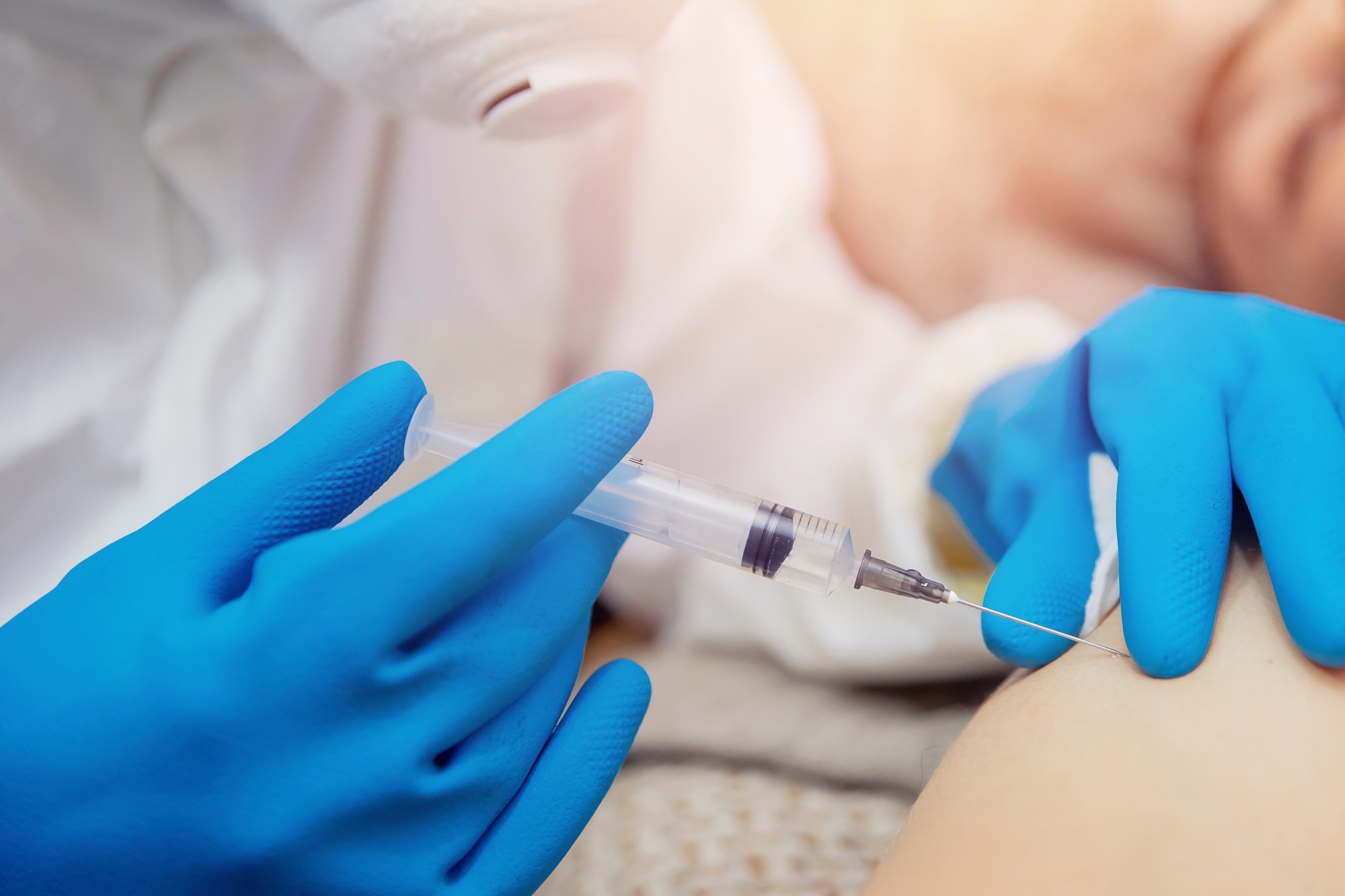A recent study published in Cell Reports demonstrated that vaccine-induced antibody functions against severe acute respiratory syndrome coronavirus 2 (SARS-CoV-2) diminish with age.
 Study: BNT162b2 induced neutralizing and non-neutralizing antibody functions against SARS-CoV-2 diminish with age. Image Credit: Parilov/Shutterstock
Study: BNT162b2 induced neutralizing and non-neutralizing antibody functions against SARS-CoV-2 diminish with age. Image Credit: Parilov/Shutterstock
Neutralizing antibodies (nAbs) SARS-CoV-2 represent one of the core measures of coronavirus disease 2019 (COVID-19) vaccine efficacy. Moreover, protection from hospitalization remains high even when neutralization is attenuated against SARS-CoV-2 variants. Polyclonal antibody responses and their role in COVID-19 are partially understood.
Antibodies function through fragment antigen-binding (Fab) and fragment crystallizable (Fc) domains that induce neutralizing and non-neutralizing functions, respectively. By binding to Fc receptors on immune cells, Fc domains induce a host of responses against antigens recognized by Fab domains. Therefore, Fc effector functions could potentially impact outcomes in COVID-19.
Studies using anti-SARS-CoV-2 monoclonal antibodies (mAbs) report the protective nature of Fc effector functions. Conversely, evidence suggests that in polyclonal responses during COVID-19, Fc effector functions could be pathogenic. However, the multiple Fc effector functions in infection/disease hint that these responses could influence outcomes if vaccine-induced.
The study and findings
In the present study, researchers evaluated immune sera from double-vaccinated SARS-CoV-2 infection-naïve healthcare workers (HCWs) to assess the relationship between Fc and Fab domain functions in polyclonal responses. The research team collected sera from 51 adults (aged 21 – 82) vaccinated with two BNT162b2 doses until February 2021. A confirmatory test was performed to rule out past COVID-19 diagnoses.
All individuals had detectable SARS-CoV-2 receptor-binding domain (RBD)-specific immunoglobulin G (IgG) compared to 51% of participants with antigen-specific IgA. Neutralization tests were performed using live SARS-CoV-2 (WA1 isolate). All participants had detectable neutralizing activity. Regression analysis indicated that neutralizing activity depended on anti-RBD IgG antibodies but not IgA.
Further, live virus neutralization tests were performed using SARS-CoV-2 Alpha, Beta, Gamma, Delta, and Omicron (BA.2) variants. Neutralization against variants was reduced relative to wild-type, with the lowest against the BA.2 variant, concordant with various studies. Specifically, only 57% of participants had detectable neutralizing activity against BA.2 compared to all participants with detectable activity against the Alpha variant.
Sex-based differences in neutralizing activity were not observed, albeit there was a negative correlation between neutralizing activity and age. Next, the researchers measured anti-RBD IgG binding to activating receptors – Fc Gamma receptor IIIa (FcγRIIIa) and FcγRIIa – and the inhibitory receptor, FcγRIIb. IgG binding to these receptors was positively correlated with neutralizing activity.
The downstream consequences of activation were determined by measuring antibody-dependent (AD) natural killer (NK) cell activation (ADNKA) that results in AD cellular cytotoxicity (ADCC), AD complement deposition (ADCD), and AD cellular (ADCP) and neutrophil phagocytosis (ADNP). The neutralizing titers were positively correlated with all ADNKA markers; however, this relationship was not observed with ADCP and ADNP.
The associations between FcγRIIIa NK cell activation and neutralizing activity sustained against SARS-CoV-2 variants were variable. The authors examined the impact of post-translational glycosylation on vaccine-elicited IgG. The relative abundance of N-glycans RBD- and non-antigen-specific IgG was measured. The glycoforms were distinct on antigen- and non-antigen-specific IgG across individuals.
Glycoforms containing sialic acids, galactose, fucose, and N-acetylglucosamine differed significantly between RBD- and non-antigen-specific IgG. The relative abundance of RBD-specific IgG glycoforms correlated with ADNKA markers. The presence of fucose (fucosylated) and the absence of sialic acid (asialylated) on IgG resulted in a negative correlation with ANDKA, indicating an inhibitory effect of IgG fucosylation. In contrast, the sialylated glycoforms positively correlated with ADNKA.
In linear regression analysis, there was a negative association between FcγR-binding RBD-specific IgG and age. Consistently, age was negatively associated with anti-RBD IgG-mediated ADNKA. Notably, the relative abundance of asialylated fucosylated species on anti-RBD IgG was higher in individuals aged 65 years or above.
Twenty-eight individuals exhibited neutralization activity against all five SARS-CoV-2 variants, whereas the remaining individuals had 50% - 83% neutralization breadth. These 28 individuals (median age 39) were younger than the remaining participants, implying that Fab- and Fc-mediated neutralization breadth and potency were attenuated with age.
The researchers computed polyfunctional breadth for each individual. They found that most younger participants (< 65 years) had high polyfunctional breadth compared to the low or medium polyfunctional breadth of those above 65 years. Moreover, the polyfunctional coordination between antibody functions and features was low in older participants (65 years or above), while there was more coordination among younger individuals.
Conclusions
The study demonstrated that two BNT162b2 vaccine doses induced coordinated functions of nAbs and non-nAbs. Both quality and quantity were critical for nAb and non-nAb functions. Neutralizing activity correlated with FcγRIIIa-mediated activation of NK cells leading to ADCC but not ADNP or ADCD. Engagement with the FcγRIIIa receptor was associated with post-translational sialylation and afucosylation of specific IgG antibodies, which differed with age.
Antibody functions were reduced in older participants (65 years or above), indicating compromised vaccine-induced polyfunctional responses. The results suggest that non-nAb effector functions serve as immune correlates and could inform about the potential of SARS-CoV-2 vaccines to prevent disease, which is an important outcome given the continual appearance of mutant SARS-CoV-2 variants that evade neutralization.
Journal reference:
- Bates, T.A., Lu, P., Kang, Y.j., Schoen, D., Thornton, M., McBride, S.K., Park, C., Kim, D., Messer, W.B., Curlin, M.E., Tafesse, F.G., Lu, L.L., (2022). BNT162b2 induced neutralizing and non-neutralizing antibody functions against SARS-CoV-2 diminish with age. Cell Reports. doi: https://doi.org/10.1016/j.celrep.2022.111544 https://www.sciencedirect.com/science/article/pii/S2211124722014000